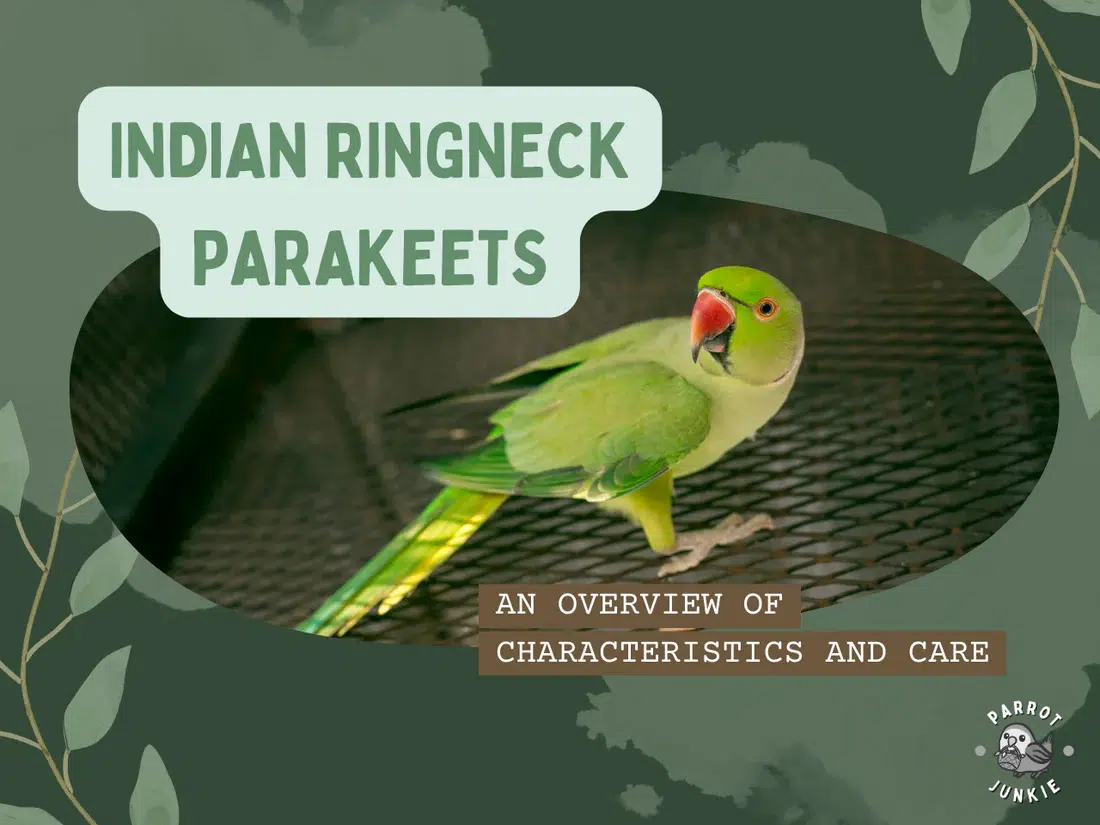
Indian Ringneck Parakeets – An Overview of Characteristics and Care
Indian Ringneck Parakeets, also known as Rose-ringed Parakeets, are a captivating bird species that have become increasingly popular as pets in recent years. With their striking plumage, charismatic presence, and impressive ability for vocal mimicry, these birds have carved a niche in the hearts of avian enthusiasts around the globe.
Originating from regions of Asia and Africa, Indian Ringneck Parakeets have a distinct charm that stems from their vibrant colors and the distinctive ring around their necks, most prominently seen in males. Their intelligent nature and playful demeanor further accentuate their appeal as pets, leading many bird lovers to consider adopting these feathery companions.
Jump To Section
Where Indian Ringnecks Live In Nature
The Indian Ringneck Parakeet (Psittacula krameri) is native to a wide geographic range that covers parts of South Asia and Africa. These birds are found in countries like India, Pakistan, Bangladesh, Nepal, Sri Lanka, and regions of northern and central Africa.
In the wild, Indian Ringneck Parakeets inhabit a variety of habitats, including forests, woodland areas, agricultural lands, and even urban parks and gardens. They are highly adaptable birds, able to thrive in diverse environments, from lush forests to bustling cities.
Living predominantly in flocks, Indian Ringneck Parakeets display a strong social structure. Their diet in the wild mainly consists of fruits, vegetables, nuts, seeds, berries, and blossoms. Understanding the parakeets’ lifestyle and dietary habits in their natural habitat provides valuable insights into their care in captivity.
In their native regions, these birds are renowned for their distinctive call, which echoes through their habitats, particularly during dawn and dusk. This deep connection with their environment and social dynamics offers a fascinating glimpse into the natural behaviors of these birds.
Physical Characteristics of Indian Ringnecks
Indian Ringneck Parakeets are medium-sized parrots, typically measuring between 14 to 17 inches (35-43cm) in length from head to tail. They weigh approximately 4 ounces (113 grams) on average.
These birds are renowned for their striking coloration. The natural coloration, known as “wild type,” features a bright green body that fades into a blue tail. Males sport a distinguishing black and rose-colored ring around their necks, a feature that gives the bird its alternative name of “rose-ringed parakeet”. This ring is generally absent in females. Females may have a hint of a light-colored ring, but it is far less pronounced and is often called a “shadow ring” among pet owners.
Various color mutations have been bred in captivity, resulting in Indian Ringneck Parakeets in a rainbow of hues, including blue, yellow, white, gray, and even violet.
Indian Ringneck Parakeets have a characteristic slender, elongated body shape compared to other parrot species. They have long tail feathers, a sharp, hooked beak suitable for cracking nuts and seeds, and zygodactyl feet (two toes pointing forward and two backward) that aid in climbing and handling food.
Additionally, they are known to have a bright red beak that is distinctive. For most wild-type parakeets, the upper beak may have some black edging, and the lower beak can be fully black in color. In lutino (yellow) and albino (white) mutations, both upper and lower beaks are fully red in color.
Indian Ringneck Parakeet Behavior and Personality
Known for their vibrant personalities, Indian Ringneck Parakeets are intelligent, playful, and energetic birds. They are known for their strong sense of independence and can be quite self-entertaining, but they also appreciate engaging playtime and interaction with their human companions.
A unique aspect of the Indian Ringneck Parakeet’s behavior is its impressive ability for vocal mimicry. These birds are known to develop extensive vocabularies and can mimic a variety of sounds, including human speech, with remarkable clarity. It’s important to note that while both males and females can mimic sounds, males are generally more proficient talkers.
Indian Ringneck Parakeets are also known for their curiosity. They love to explore their surroundings and are often eager to inspect new toys or objects in their environment. This curiosity can also extend to their interactions with humans. They may be initially shy around new people, but once they warm up, they can form deep bonds with their caretakers.
Like all parrots, Indian Ringneck Parakeets can display a range of emotions, including happiness, curiosity, fear, and agitation. Learning to recognize these emotions and respond accordingly is a critical part of caring for these birds.
Despite their endearing qualities, these birds can sometimes be perceived as feisty or nippy, particularly during their ‘bluffing’ phase in adolescence. This phase, characterized by increased biting or territorial behavior, is temporary and can be managed with patience and appropriate training.
Bluffing
“Bluffing” is a phase that many Indian Ringneck Parakeets go through during their adolescence, typically starting around four months of age and lasting until they’re around a year old or more. It’s a critical stage in the bird’s development, where they test boundaries and establish their place in the flock’s social hierarchy, or in this case, their household.
During this bluffing stage, you may observe a variety of behaviors that are generally uncharacteristic of your bird’s normal demeanor. They may become nippier or even outright bite, show signs of aggression, or exhibit territorial behaviors. They might start making more noise, or may suddenly seem frightened of their owners.
While these behaviors can be challenging to deal with, it’s important to remember that this is a normal stage of development for Indian Ringneck Parakeets and most other parrot species. Here are some tips to manage this stage:
- Patience: Patience is key during this time. Remember, this is a temporary phase that should pass with time.
- Consistent Handling: Continue to handle your bird regularly, but respect their signals. If they seem agitated or fearful, give them some space.
- Positive Reinforcement: Reward good behavior with treats and praise, and avoid reinforcing negative behaviors.
- Provide Toys and Stimulation: Make sure your bird has plenty of toys and mental stimulation to help channel their energy into positive activities.
- Avoid Punishment: Never punish your bird for bluffing behaviors. This can damage your relationship with them and potentially lead to more behavioral problems.
- Seek Professional Help: If the bluffing stage seems excessively long or the behaviors are causing significant issues, consider seeking advice from an avian veterinarian or bird behaviorist.
While the bluffing stage can be a challenging time for pet owners, with patience, consistency, and understanding, you’ll both come out of it with a stronger bond.
Indian Ringneck Parakeets’ Dietary Requirements
The diet of an Indian Ringneck Parakeet plays a critical role in its overall health and well-being. These birds require a varied and balanced diet to ensure they receive all the necessary nutrients.
- Pellets: A high-quality, commercially prepared pellet should form the basis of your parakeet’s diet. Pellets are typically formulated to provide a balanced mix of nutrients, making them an essential part of the dietary routine.
- Fresh Fruits and Vegetables: Fresh foods should be provided daily. Safe options include apples, pears, oranges, bananas, strawberries, carrots, peas, sweet potatoes, broccoli, and leafy greens like spinach and kale. Always wash fresh produce thoroughly to remove any traces of pesticides.
- Seeds and Nuts: While seeds and nuts are a part of the Indian Ringneck’s natural diet, they should be offered sparingly in captivity due to their high-fat content. They can be used as treats or as part of a foraging activity to stimulate mental engagement.
- Water: Fresh water should always be available and changed daily, or more frequently if soiled.
There are also certain foods that should be avoided, as they can be harmful to Indian Ringneck Parakeets. These include avocado, chocolate, alcohol, caffeine, and any food high in salt, sugar, or artificial additives.
Housing and Environmental Needs
Indian Ringneck Parakeets, with their active nature and curiosity, require a specific type of environment to thrive. Below are some key considerations:
Cage Size and Setup
Due to their size and high energy levels, Indian Ringneck Parakeets need a spacious cage to stretch their wings and exercise. A minimum recommended cage size is 24 inches wide, 24 inches deep, and 36 inches high (60cm x 60cm x 90cm). However, if possible, a larger cage is always better. Cage bar spacings should not be bigger than 1/2″ to 5/8″ (~1.2-1.6cm) as their heads might get stuck between wider cage bars.
The cage should have horizontal bars that allow the bird to climb and have several perches of varying thicknesses to promote foot health. Be mindful to position perches in a way that droppings do not contaminate food or water dishes.
Cleanliness is crucial to prevent diseases. Regularly clean the cage, perches, and toys with bird-safe disinfectants. Food and water dishes should be cleaned daily.
Toys and Mental Stimulation
Indian Ringneck Parakeets are intelligent and very curious birds, and their environment should provide plenty of mental stimulation. This can be accomplished with a variety of toys such as foraging toys, swings, ladders, and chew toys. Regularly rotating the toys can keep the environment interesting and stimulating.
Teaching them to perform tricks can be a great way to bond with them daily and to keep their minds active.
Light and Temperature
Like all parrots, Indian Ringnecks need a regular light-dark cycle to maintain their biological rhythms. During the day, the cage should be in a well-lit area, but not in direct sunlight, which can overheat the cage. For sleep, they need a quieter and darker environment such as a dark room or covered cage.
In terms of temperature, Indian Ringneck Parakeets are comfortable in average household temperatures, roughly between 65-80 degrees Fahrenheit (18-26 degrees Celsius), and should be kept out of drafts. The general rule of thumb is to avoid sudden, drastic changes in temperatures, or to leave them in excessively warm or cold conditions for long periods of time.
Environmental Safety
Daily out-of-cage time is essential for exercise and social interaction. The out-of-cage area should be bird-proofed to ensure the bird’s safety. This requires a safe, bird-proof space where they can’t access toxic plants, open water sources (such as open-top fish tanks), or potentially harmful household items such as electrical cables, spinning ceiling fans, heated stoves, lit candles, incense sticks, and so on.
Socialization and Interaction with Indian Ringneck Parakeets
Indian Ringneck Parakeets are social and intelligent birds that require regular interaction and stimulation. In their natural habitat, Indian Ringneck Parakeets live in large flocks and are seldom alone. They thrive on social interaction, and in captivity, they require daily interaction with their human caretakers or other birds. Without proper socialization, these birds can become bored, which can lead to issues like feather plucking or excessive noise.
Regular, gentle handling can help foster a bond between you and your Indian Ringneck Parakeet. Training your bird to step up onto your hand or arm is a beneficial skill that aids handling. Remember to always move slowly and predictably around your bird to avoid causing fear or stress.
Indian Ringneck Parakeets may exhibit various behavioral problems if their needs are not met. These could include feather plucking, aggression, or excessive noise. Often, these issues can be resolved or minimized by ensuring your bird has a balanced diet, sufficient mental stimulation, regular social interaction, and a comfortable environment. If behavioral issues persist, it’s recommended to consult an avian veterinarian or bird behaviorist.
Remember that while Indian Ringneck Parakeets are generally sociable, they also value their independence. Respecting your bird’s individual personality and signals is key to establishing a harmonious relationship with them.
Indian Ringneck Parakeets’ Health and Lifespan
Indian Ringneck Parakeets have a relatively long lifespan compared to other pet birds. With proper care and nutrition, these parakeets can live between 20 to 30 years, and some have been known to live even longer.
Despite their hardy nature, Indian Ringneck Parakeets can be prone to certain health issues. Obesity is a common problem often linked to a lack of exercise or an unbalanced diet. Respiratory issues can arise from exposure to drafts, toxins in the air (such as smoke or chemical fumes), or bacterial and viral infections.
Feather plucking can be a sign of stress, boredom, or underlying health issues, including skin conditions or internal parasites. A proper diet and environmental enrichment can help prevent this, but persistent issues should be checked by a veterinarian.
Psittacine Beak and Feather Disease (PBFD), a viral disease causing feather loss and beak abnormalities, can affect Indian Ringnecks, and a veterinarian should promptly check any changes in feather or beak health.
Routine veterinary check-ups are an essential part of keeping your Indian Ringneck healthy. These check-ups can catch potential health problems early and ensure that your bird is in good health. As a rule of thumb, schedule a check-up at least once a year, or more often if your bird is older or has known health issues.
Keeping a close eye on your bird’s behavior, eating habits, and physical appearance can help you spot potential problems early. Changes such as lethargy, loss of appetite, changes in droppings, or unusual behavior warrant an immediate vet visit.
Breeding and Reproduction
Indian Ringneck Parakeets reach sexual maturity around the age of 2-3 years. In the wild, they typically breed from January to March, but in captivity, they can breed almost year-round. It’s essential to ensure that both birds in a pair are healthy and mature enough for breeding.
Females typically lay a clutch of 2 to 6 eggs, which they will incubate for around 23 days. Both parents will take care of the chicks once they hatch, feeding them and keeping them warm.
There are several important considerations for anyone thinking of breeding Indian Ringneck Parakeets:
- Health: Both parents should be healthy and free from any genetic conditions that could be passed onto the offspring.
- Age: Ensure that both birds are of appropriate age and physical maturity.
- Environment: A calm, stress-free environment is essential. The breeding pair will also need a suitable nest box in their cage.
- Diet: Breeding birds have higher nutritional needs, so ensure their diet is balanced and sufficient.
- Chick Care: Be prepared to step in if the parents neglect their chicks. This may involve hand-feeding the chicks, which requires knowledge and experience.
- Future Homes: Have a plan for the chicks once they’re weaned. Only consider breeding if you’re sure you can find responsible homes for all the offspring.
- Remember, breeding should not be undertaken lightly. It’s a significant responsibility and requires a commitment to the welfare of both the parents and their offspring.
Indian Ringneck Parakeets come in a wide variety of color mutations thanks to selective breeding by aviculturists. Here are some of the most common color variants you may encounter:
- Green (Wild Type): This is the natural coloration of Indian Ringneck Parakeets in the wild. These birds sport bright green feathers over the majority of their bodies, with a blue tail and red beak. Males have a black and rose-colored ring around their neck.
- Blue: Blue Indian Ringnecks are a stunning mutation. These birds are a vibrant, sky-blue color throughout their bodies, resulting from the absence of yellow pigmentation. The characteristic pink neck ring in males appears as a white or light silver color.
- Yellow (Lutino): The lutino mutation results in birds with bright yellow feathers and a fully-red beak. This mutation is the result of the absence of blue and green pigments. In lutinos, the black ring on males is usually absent, replaced by a white ring.
- White (Albino): Albino Indian Ringnecks lack all pigmentation, resulting in pure white feathers and a red or pinkish beak. Their eyes are typically red. Like lutinos, male albinos usually lack the characteristic neck ring.
- Gray: Gray Indian Ringnecks are muted in color, with a beautiful, smoky gray hue covering their bodies. This mutation is less common than some others.
- Cinnamon: This mutation results in a body color that’s a beautiful warm cinnamon or faded shade. This mutation is also quite rare.
- Violet: This color mutation is quite rare and results in a bird with gorgeous violet-blue feathers.
It’s important to note that all these color mutations are simply variations in the bird’s physical appearance. Regardless of their feather color, all Indian Ringneck Parakeets have similar behavior, diet, and care needs.
Conclusion
Indian Ringneck Parakeets, with their captivating colors, intriguing behavior, and impressive lifespan, make fascinating and rewarding companions for the right owners. Their charming personality and striking appearance have earned them a beloved place in the world of aviculture.
However, their care requires commitment, understanding, and patience. From their diverse dietary needs to their spacious housing requirements, every aspect of their care plays a crucial role in their well-being and overall lifespan. Their vibrant personalities demand meaningful social interaction and mental stimulation, contributing significantly to their health and happiness.
Understanding the stage of bluffing typical in young Ringnecks, learning to recognize the signs of common health issues, and being prepared for their breeding habits if you choose to breed are also essential aspects of their care.
Furthermore, the various color mutations found in this species make them a delight for those who appreciate the diversity of avian appearances, but it’s crucial to remember that regardless of their exterior, all Indian Ringneck Parakeets share the same basic care needs.
As a potential or current owner, equipping yourself with this knowledge will ensure you provide the best environment for your Indian Ringneck Parakeet, contributing to a rewarding and lasting companionship.
Parrot Junkie www.parrotjunkie.com
Copyright © 2021-2024. All rights reserved.



Be the first to leave a comment